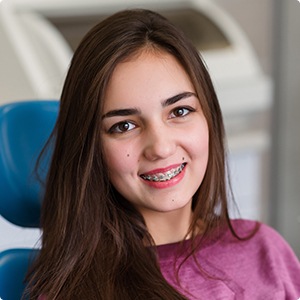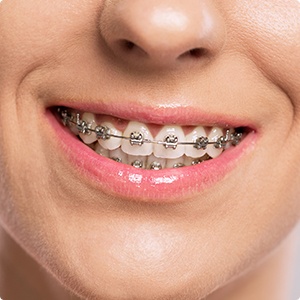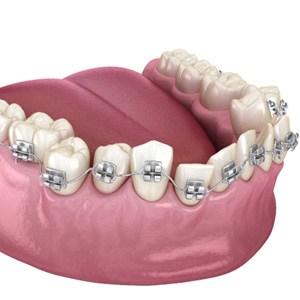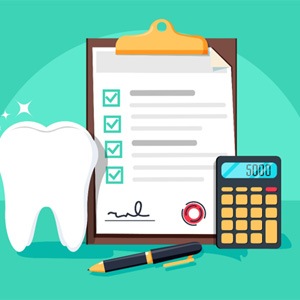
Traditional Braces – Enfield, CT
A Solution You Can Trust

Traditional metal braces have been around for decades, and they are still one of the most common treatments used. The reason for this is simple: they work! The orthodontist bonds the braces (brackets) to the teeth and they stay there. One of the concerns that many parents have with clear aligners is that their child can remove the aligners and not wear them, or worse, remove them at school, place the aligners on their lunch tray and end up in the trash. With braces, Dr. Cordes can not only straighten the teeth to improve the appearance of the smile, but he can enhance oral function as well, enabling a patient to eat, speak, and even breathe more comfortably. If your child’s orthodontist has recommended that they get traditional braces in Enfield, CT or you’re ready to correct your own orthodontic issues, Dr. Cordes can use this reliable method to deliver stunning results, just like he has for the past 20 years.
Braces Basics

If you need a slight refresher on braces, don’t worry – most people haven’t really thought about them since they were in elementary school!
They work using the basic principle that underlies all orthodontics—a slight pressure is applied to the teeth in order to shift them into their ideal positions. This is accomplished by placing a specially-bent wire along each row of teeth, which is held in place using metal brackets bonded to each tooth. Over the course of treatment, the wire is gradually tightened until the teeth are perfectly aligned, according to a treatment plan designed by Dr. Cordes.
What Can Braces Fix?

Dr. Cordes can use traditional metal braces to address all of the following issues, usually at the same time:
- Crooked teeth
- Crowded teeth
- Spaces between teeth
- Overbite
- Underbite
- Crossbite
How Long Do Braces Take?

Treatment time with braces can vary quite a bit from person to person, depending on the complexity of their alignment issues. On average, a patient should expect to be in braces for about 1-3 years. Dr. Cordes can give you a more definitive timeline when you come to see him for a consultation. By following his instructions closely during treatment, patients are often able to shave months off of the process.
Understanding the Cost of Traditional Braces

The total cost of traditional braces in Enfield depends on the details of your treatment. For example, a case that lasts just one year will of course be less expensive than one that takes multiple years to complete. During your consultation, our team here at Cordes Orthodontics will be able to evaluate your situation and provide you with a personalized cost estimate. In the meantime, the following information may help you to anticipate what will be involved in paying for your treatment.
Factors That Affect the Cost of Traditional Braces

Several factors can affect the cost of braces, including:
- The severity of your misalignment: This affects treatment length, what type of accessories you will need, and more. It is the most significant contributing factor to the overall price of braces.
- Age: Adults’ teeth tend to move more slowly than those of teenagers, which can make treatment more complex and slightly more costly.
- The number of appointments needed: Braces must be adjusted periodically throughout the treatment. How frequent your appointments are can influence the total cost of your care.
- Compliance with treatment guidelines: Failing to wear your elastics, or eating food that damages your braces, can delay your treatment and incur extra expenses.
Professional Braces vs. “DIY” Braces: Which Costs More?

You might have seen reports on social media about people who have created their own “braces” using household objects, such as fishing line, Super Glue, and paperclips. At first, such methods might seem like a feasible solution for saving money, especially if you are on a tight budget and don’t want to spend thousands of dollars on professional braces.
However, extreme caution is in order. Many people who have tried DIY braces end up worsening their dental misalignment. They may also harm their tooth enamel and gums. Correcting such issues can be much more expensive and uncomfortable than investing in professional treatment in the first place.
Does Dental Insurance Cover Braces?

Some higher-end dental insurance plans cover braces. Typically, such plans have a lifetime orthodontic maximum, which covers 50 percent of the cost of treatment up to the given spending limit. A few plans limit their orthodontic coverage to patients under the age of 18 or 19.
Our team will be happy to help you navigate your benefits and file your claims. If your plan does not cover braces, you might consider using your flexible spending account or healthcare savings account to pay for them.
Another Option for Making Braces Affordable

If you don’t have insurance coverage for braces, consider this to make it easier for you to afford them:
- Financing: We are partnered with CareCredit, plus we offer in-office financing. Both options provide little-to-no interest plans with flexible schedules and clear terms so you can breathe easy when it comes to paying for your orthodontic treatment.
Are you ready to learn more about braces and their cost? Contact our team today to schedule your consultation with Dr. David Cordes.
Traditional Braces FAQs

Many of our patients are already familiar with braces and have a rough idea of have they work, but they still have a few concerns that they want to address before starting treatment for themselves or their children. If you read below, you’ll find some of the questions that we’ve heard most often when it comes to traditional orthodontics. Before you call our office, take the time to review the FAQs below to see if the answers you’re looking for are already there.
Am I Too Old to Get Braces?
There is no actual upper age limit for traditional braces; the treatment is just as effective for adults as it is for children. It does tend to take longer in older patients since the teeth are more firmly embedded in the jaw, but the results are just as reliable. More important than your age is the condition of your jawbone and teeth. Some people may need to have dental work done before they start wearing braces so that oral health issues like gum disease don’t disrupt the orthodontic process. Also, remember that some dental insurance plans only cover orthodontic care for kids and not adults, so out-of-pocket costs may be larger for older patients.
Do Traditional Braces Hurt?
Most people experience some soreness in their teeth and gums right after their braces are first attached. Normally, you can expect this soreness to fade after about a week, and you can use pain relievers to help manage your discomfort until then. The soreness may return for a few days whenever we tighten your braces, and you may occasionally notice a small amount of discomfort as a result of the brackets and wires gradually shifting the teeth, but it shouldn’t be as bad as the first week. If your braces are irritating the soft tissues inside your mouth, try covering parts of them with orthodontic wax.
Can I Chew Gum with Traditional Braces?
Chewing gum is one of the activities that you’ll typically be told to avoid while wearing traditional braces. Gum is very sticky and could end up bending the wires; as a result, the teeth could end up shifting in a way that wasn’t intended, which could end up prolonging the amount of time you need to wear your braces. You might see some sources online claiming that there are benefits to chewing sugarless gum while wearing braces, but they most likely are not worth the risk of disrupting your treatment.
Why Do My Teeth Feel Loose with Braces?
Some patients are alarmed when they notice that their teeth feel looser than they normally do, but when it comes to braces, this is actually a good sign. The treatment works by slightly loosening the ligaments holding the teeth in place so that they can be repositioned; as such, it’s perfectly normal for the teeth to feel as though they’re looser than normal. The sensation will subside after your braces have been removed and your jaw has gotten used to the new positions of your teeth.